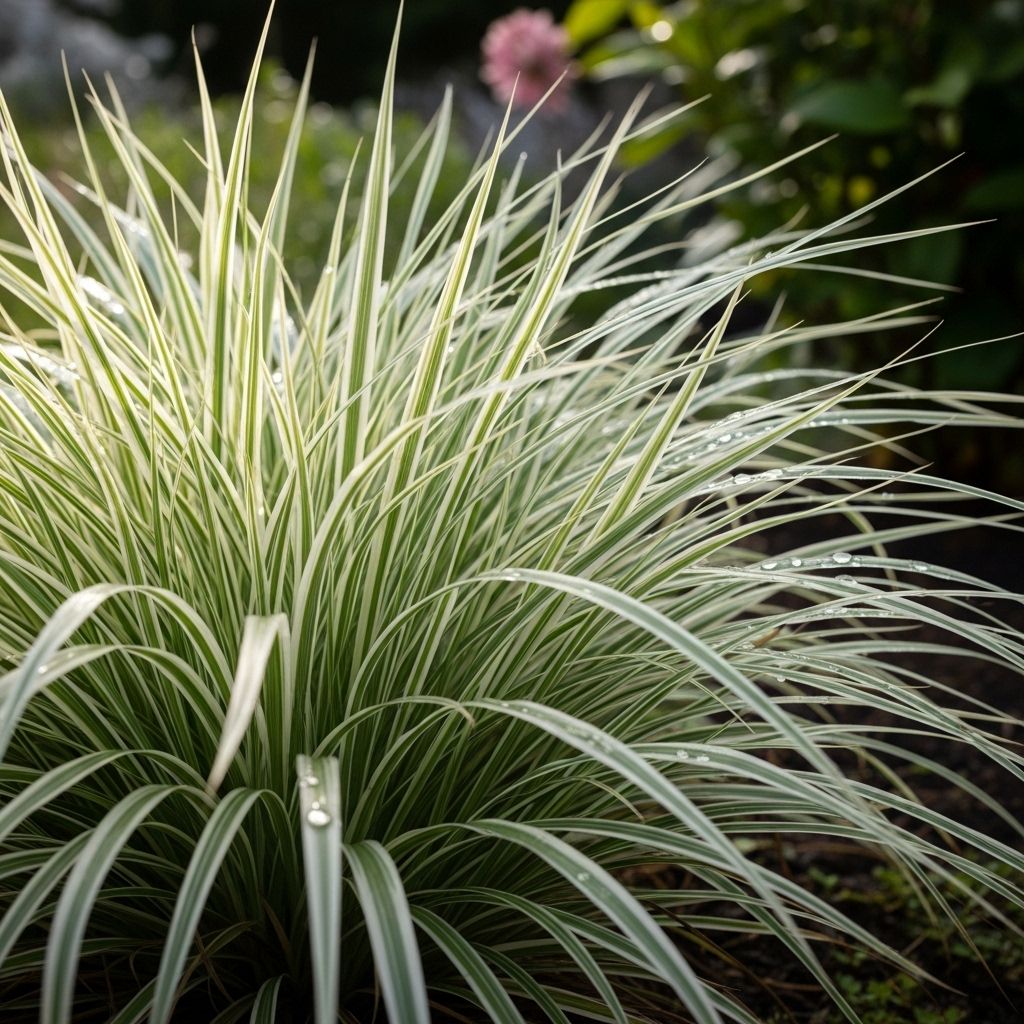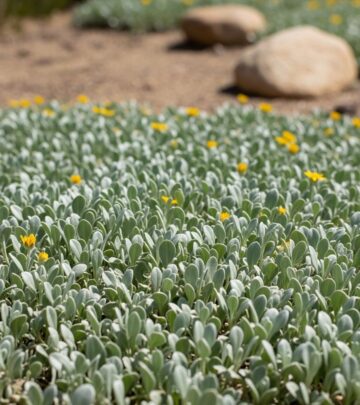Ribbon Grass Care: Expert Tips For Vibrant Variegation
Master the art of growing this distinctive ornamental grass in your garden landscape

Image: HearthJunction Design Team
Introduction to Ribbon Grass
Ribbon grass (Phalaris arundinacea), also known as gardener’s garters or reed canary grass, is a distinctive ornamental grass prized for its eye-catching variegated foliage. With its striking white and green striped leaves that dance gracefully in the breeze, this perennial grass adds texture, movement, and visual interest to garden landscapes throughout the growing season. Native to wetlands and riverbanks across Europe, Asia, and North America, ribbon grass has become a popular choice for gardeners seeking low-maintenance plants with high visual impact.
The distinctive appearance of ribbon grass makes it instantly recognizable in garden settings. The plant typically grows in upright clumps reaching 2 to 3 feet in height, with arching, lance-shaped leaves sporting bold longitudinal stripes in varying shades of green and creamy white. This dramatic variegation creates an almost ribbon-like appearance, lending the plant its common name and making it a standout specimen in ornamental beds, borders, and naturalized areas.
While ribbon grass offers undeniable aesthetic appeal and adaptability, it’s important to understand its growth habits and potential for spreading before introducing it to your garden. With proper placement and management, ribbon grass can be a valuable addition to diverse garden styles, from cottage gardens to modern landscapes, providing year-round interest and architectural structure.
Characteristics and Varieties
Ribbon grass belongs to the Poaceae family and is a rhizomatous perennial grass, meaning it spreads via underground stems that can extend outward from the parent plant. This growth habit contributes to its robust nature but also explains its potential to become invasive in ideal growing conditions. The plant forms dense clumps that gradually expand outward, creating a lush, textural mass of foliage.
The most commonly cultivated variety is Phalaris arundinacea ‘Picta’, which features the classic green and white variegated leaves that have made ribbon grass a garden staple. The leaves typically reach about 8-10 inches in length with prominent striping patterns that can vary in intensity depending on growing conditions. During summer, the plant may produce spiky flower panicles that rise above the foliage, adding another dimension of visual interest, though the foliage remains the main attraction.
In addition to ‘Picta’, several other cultivated varieties exist, including:
- ‘Feesey’s Form’ – Features leaves with pink-tinged variegation that’s particularly striking in spring
- ‘Strawberries and Cream’ – Displays pink and white variegation that creates a softer, more delicate appearance
- ‘Tricolor’ – Exhibits green, white, and pink striping for maximum visual impact
While the variegated forms are most popular in ornamental gardens, it’s worth noting that the plain green species form (without variegation) is generally more aggressive and is considered invasive in many regions. For garden use, always select the variegated cultivars, which tend to be somewhat less vigorous.
Planting Ribbon Grass
Successful establishment of ribbon grass begins with proper site selection and planting techniques. While adaptable to various conditions, ribbon grass performs best when its basic growing requirements are met.
When to Plant
The optimal time to plant ribbon grass is in early spring or fall when temperatures are moderate and rainfall is typically more abundant. These seasons allow the plant to establish its root system before facing the stress of summer heat or winter cold. In warmer climates, fall planting is often preferred as it gives the grass ample time to develop strong roots before the following summer.
Site Selection
Ribbon grass accepts a wide range of growing conditions, which contributes to both its popularity and its potential invasiveness. For optimal growth and appearance:
- Light requirements: Plant ribbon grass in partial shade to full sun positions. In hotter regions, providing afternoon shade will help prevent leaf scorch and maintain the vibrant variegation.
- Soil conditions: This adaptable grass tolerates everything from dry to consistently wet soils, though it thrives in moist, well-draining conditions. It can grow in poor soils but performs best in those enriched with organic matter.
- Spacing: Allow 18-24 inches between plants when establishing a new planting, as ribbon grass will fill in quickly.
Planting Process
To plant ribbon grass:
- Dig a hole slightly larger than the root ball of your plant.
- Amend the soil with compost if planting in poor soil.
- Position the plant at the same depth it was growing in its container.
- Backfill with soil, firming gently to eliminate air pockets.
- Water thoroughly after planting to help settle the soil around the roots.
- Apply a layer of mulch around the plant (but not directly against the stems) to conserve moisture and suppress weeds.
For container planting, select a pot with ample drainage holes and use a high-quality potting mix. Container cultivation is an excellent way to enjoy ribbon grass while controlling its spreading tendency.
Care and Maintenance
One of ribbon grass’s main attractions is its relatively low maintenance requirements once established. However, some regular care will ensure the plant looks its best and remains contained within its intended boundaries.
Watering
Ribbon grass is remarkably adaptable to different moisture conditions. While it naturally grows in wet areas and can tolerate consistently moist soil, established plants also display good drought tolerance for short periods. For optimal appearance:
- Water newly planted ribbon grass regularly until established.
- Once established, provide supplemental irrigation during extended dry periods.
- Plants in full sun locations will require more frequent watering than those in partial shade.
- Signs of drought stress include browning leaf tips and edges.
Fertilizing
Ribbon grass is not a heavy feeder and excessive fertilization can actually reduce the distinctiveness of its variegation. A light application of balanced, slow-release fertilizer in early spring is typically sufficient. Alternatively, working compost or well-rotted manure into the soil around the plants provides nutrients while improving soil structure.
Pruning and Seasonal Care
Regular maintenance keeps ribbon grass looking attractive throughout the growing season:
- Spring: Cut back all old foliage to within a few inches of the ground before new growth emerges. This rejuvenation pruning promotes fresh, vibrantly colored new growth.
- Summer: Remove any brown or scorched leaves to maintain the plant’s appearance. If growing in full sun, leaves may occasionally scorch during hot weather – simply trim these away and the plant will quickly produce new foliage.
- Fall: In warmer regions, ribbon grass remains semi-evergreen and can be left standing for winter interest. In colder areas, the foliage may die back naturally.
- Winter: In colder climates (USDA zones 4-5), apply a layer of mulch around the base of plants to protect the roots from freezing temperatures.
Dividing
Dividing ribbon grass every 2-3 years helps rejuvenate the plant and control its spread. The best time to divide is in early spring just as new growth begins to emerge. Dig up the clump, divide it into smaller sections using a sharp spade or knife, and replant the divisions at the same depth as the original plant. Discard any unwanted sections rather than composting them to prevent unintentional spreading.
Controlling Spread and Invasiveness
The vigorous growth habit that makes ribbon grass so reliable can also become problematic in certain settings. Understanding how to effectively manage its spreading tendency is crucial for responsible cultivation.
Containment Methods
Several strategies can help keep ribbon grass within bounds:
- Root barriers: Install physical barriers such as deep edging or buried pots to limit rhizome spread. These should extend at least 12 inches deep.
- Container planting: Growing ribbon grass in containers eliminates the risk of unwanted spreading while showcasing its ornamental qualities.
- Strategic placement: Plant ribbon grass in locations where its spread is naturally limited, such as between structures or along hardscape elements.
- Regular monitoring: Inspect the perimeter of plantings regularly and promptly remove any shoots appearing beyond the desired boundary.
For gardens near natural waterways or wetlands, it’s especially important to prevent ribbon grass from escaping cultivation, as it can displace native species in these sensitive ecosystems.
Design Applications and Companion Plants
Despite its management challenges, ribbon grass offers tremendous versatility in garden design when used thoughtfully. Its distinctive variegation and architectural form make it valuable in numerous landscape applications.
Landscape Uses
Ribbon grass can be effectively incorporated into gardens in various ways:
- Mass plantings: Creates dramatic sweeps of texture and movement in larger landscapes
- Border edges: Provides a distinctive boundary between lawn and planting beds
- Water features: Thrives at pond edges and streambanks, reflecting its natural habitat
- Erosion control: Stabilizes slopes and banks with its extensive root system
- Container specimens: Adds vertical interest and movement to container arrangements
- Cut foliage: Provides striking, long-lasting material for floral arrangements
Companion Planting
Ribbon grass pairs beautifully with plants that complement its form and coloration:
- Bold-leaved perennials: Hosta, ligularia, and rodgersia create textural contrast
- Flowering perennials: Astilbe, iris, and daylilies add seasonal color
- Other ornamental grasses: Miscanthus, festuca, and carex offer varied heights and textures
- Shrubs: Compact viburnums, hydrangeas, and spireas provide structural backdrop
When designing with ribbon grass, consider its reflective quality in capturing and amplifying light, particularly in shadier garden areas where its bright variegation can illuminate otherwise dark corners.
Seasonal Interest and Wildlife Value
While primarily grown for its foliage, ribbon grass provides multi-season appeal and ecological benefits in the garden landscape. Throughout the year, it offers changing displays that contribute to garden interest:
- Spring: Fresh new growth emerges with particularly vibrant variegation
- Summer: Mature foliage creates waves of texture, occasionally topped with delicate flower panicles
- Fall: Leaves may develop subtle pink or purple tints in cooler weather
- Winter: Dried foliage and seed heads provide structural interest and movement in the dormant garden
From an ecological perspective, ribbon grass serves as shelter for small wildlife and nesting material for birds. The seeds, though not produced in abundance by variegated cultivars, may attract some bird species in fall and winter.
Frequently Asked Questions
Q: Is ribbon grass deer resistant?
A: Yes, ribbon grass is generally avoided by deer and other browsing animals due to its coarse texture and lack of palatability, making it a good choice for gardens in areas with high deer pressure.
Q: Can ribbon grass grow in shade?
A: Yes, ribbon grass tolerates partial to full shade, though its variegation may be less pronounced in deeply shaded locations. In hot climates, some afternoon shade is beneficial for maintaining leaf quality.
Q: How quickly does ribbon grass spread?
A: Ribbon grass can spread relatively quickly via underground rhizomes, especially in moist soil. Variegated forms typically spread more slowly than the plain green species. Expect clumps to expand by several inches each year under favorable conditions.
Q: Will ribbon grass die back in winter?
A: In colder climates (USDA zones 4-5), ribbon grass will die back to the ground in winter. In milder climates, it may remain semi-evergreen. Either way, it reliably returns from its roots in spring.
Q: How can I remove ribbon grass if it becomes invasive?
A: Complete removal requires digging out all rhizomes, which may take multiple attempts. For large areas, covering with black plastic for a full growing season may be effective. Selective herbicides designed for grasses can also be used as a last resort, following manufacturer’s instructions carefully.
With its distinctive appearance and adaptable nature, ribbon grass offers gardeners a versatile ornamental plant that brings movement, texture, and visual interest to diverse landscape settings. By understanding its growing requirements and management needs, you can successfully incorporate this striking grass into your garden while keeping its spreading habit in check. Whether used as a specimen plant, ground cover, or container accent, ribbon grass rewards with multi-season appeal and minimal maintenance demands.
References
- https://www.gardenista.com/posts/gardening-101-ribbon-grass-perennial-plant-care-growing-tips/
- https://www.gardeningknowhow.com/ornamental/foliage/ribbon-grass/ribbon-grass-information.htm
- https://www.bhg.com/gardening/plant-dictionary/perennial/variegated-ribbongrass/
- https://pbndesign.com/plants/ribbon-grass/
- https://www.houzz.com/discussions/1631947/ribbon-grass-will-i-regret-planting-this
Read full bio of medha deb












